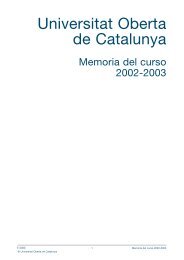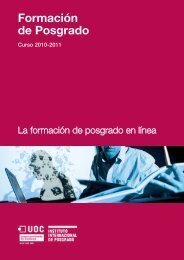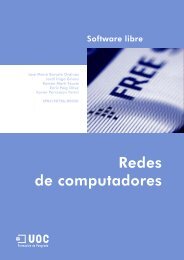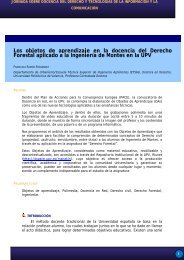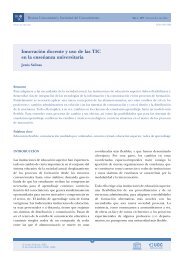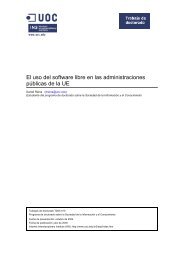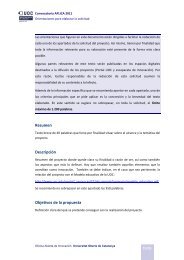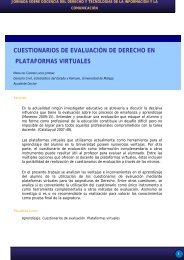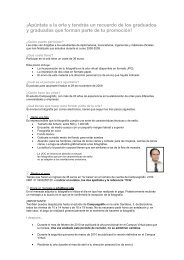e-governance and citizen information - Universitat Oberta de ...
e-governance and citizen information - Universitat Oberta de ...
e-governance and citizen information - Universitat Oberta de ...
You also want an ePaper? Increase the reach of your titles
YUMPU automatically turns print PDFs into web optimized ePapers that Google loves.
E-<strong>governance</strong> <strong>and</strong> Citizen Information 63 Methodology4.4. Empirical ResearchThe focus on the analysis of technological innovation processes led to an approach based mainly(though not exclusively) on qualitative methodologies. Therefore, the interviews <strong>and</strong> participatingobservation are the foundations on which the research project is supported. In parallel, toaddress specific aspects we have chosen the use of methodological tools with a quantitative approach(such as surveys or the analysis of social networks). In any case, the results presentedthroughout the research project are duly differentiated in accordance with their empirical source.Detailed <strong>information</strong> about the methodological tools used is shown next.4.4.1. Participating ObservationOne of the most relevant aspects of this research project is the fact that two of the three researchershad the possibility of being physically located in the Generalitat of Catalonia duringa period of almost two years (between June 2004 <strong>and</strong> May 2006). So, there was a prioragreement at the start of the research project whereby the researchers of the project couldbe physically insi<strong>de</strong> the Administration with a small work space. In particular, we were locatedin the Citizen Information Department, which allowed us to study the daily running of theAdministration <strong>and</strong> also gave us privileged access to its employees.The observation has mainly involved the monitoring tasks carried out during the <strong>de</strong>sign, <strong>de</strong>velopment<strong>and</strong> follow-up of the projects promoted by the Citizen Information Department, onwhich our analysis has been focused. The meetings were recor<strong>de</strong>d in notebooks <strong>and</strong> notonly inclu<strong>de</strong>d the <strong>de</strong>scription or account of the matters discussed, but also a first-level analysis,following an observation outline. The notes were transcribed in digital format for theirsubsequent analysis. The next step, in parallel to the theorisation activities, was the analysis<strong>and</strong> categorisation of the material with the ATLAS.ti content analysis software.4.4.2. InterviewsThe second technique used was semi-structured interviews, carried out at the end of the researchproject (between June 2004 <strong>and</strong> April 2006). A total of 106 interviews were held withdifferent people, 75 of which were carried out with Generalitat personnel <strong>and</strong> 31 were membersof the administrations of Quebec, Emilia-Romagna <strong>and</strong> Scotl<strong>and</strong>. Since the projectsstudied were evolving, various people (due to their central role in the projects analysed)have been interviewed more than once. The total number of interviews was 124.The average length of the interviews was one hour <strong>and</strong> the <strong>information</strong> gathered has beenused to draft this report in the form of quotes from the people interviewed (co<strong>de</strong>d to maintainhttp://www.uoc.edu/in3/pic




